How to Create Walking Friendly Cities. A Multi-Criteria Analysis of the Central Open Market Area of Rijeka
Abstract
1. Introduction
- -
- improve the functionality and attractiveness of the road space, separating in some cases the different pedestrian/vehicular currents
- -
- improve the safety (objective and subjective) of all road users: pedestrians, cyclists, motorists;
- -
- improve the fluidity of pedestrian flows and other types of vehicles—reduce atmospheric emissions and noise.
2. Materials and Methods
2.1. Analytical Hierarchy Process (AHP)
2.2. AHP Online System-AHP-OS
2.3. Case Study Description
- itinerary 1 (IT1) it consists of a path on the sidewalk and traffic-lighted pedestrian crossings
- itinerary 2 (IT2) also formed by a path on the sidewalk and traffic-lighted pedestrian crossings
- itinerary 3 (IT3) formed by a direct path on the sidewalk and secondary road
- itinerary 4 (IT4) formed by a direct route on the underpass
2.4. Data acquisition. Sample and Survey definition
3. Results
3.1. Data Analysis through the Use of Descriptive Statistics
3.2. Multi-Criteria Analysis through the Use of AHP Method
4. Discussion
5. Conclusions
Author Contributions
Funding
Acknowledgments
Conflicts of Interest
References
- Urban Agenda for the EU Pact of Amsterdam 2016. Available online: https://ec.europa.eu/futurium/en/system/files/ged/pact-of-amsterdam_en.pdf (accessed on 1 September 2020).
- Beets, N.; Envoy, D.U. Together towards an EU Urban Agenda. 2016. Available online: https://ec.europa.eu/regional_policy/sources/docgener/brochure/urban_agenda_eu_en.pdf (accessed on 1 September 2020).
- Agenda, U. Urban Agenda for the EU ‘Pact of Amsterdam’. In European Programme for Sustainable Urban Development; EU-European Commission: Brussels, Belgium, 2016. [Google Scholar]
- Gruden-Gruden, C.; Campisi, T.; Canale, A.; Tesoriere, G.; Sraml, M. A cross-study on video data gathering and microsimulation techniques to estimate pedestrian safety level in a confined space. IOP Conf. Ser. Mater. Sci. Eng. 2019, 603, 042008. [Google Scholar] [CrossRef]
- Bellizzi, M.G.; Eboli, L.; Forciniti, C. Segregation vs. interaction in the walkways: An analysis of pedestrians’ perceptions. Res. Transp. Bus. Manag. 2019, 33, 100410. [Google Scholar] [CrossRef]
- Dörrzapf, L.; Kovács-Győri, A.; Resch, B.; Zeile, P. Defining and assessing walkability: An concept for an integrated approach using surveys, biosensors and geospatial analysis. Urban Dev. Issues 2019, 62, 5–15. [Google Scholar] [CrossRef]
- Foltête, J.C.; Piombini, A. Deviations in pedestrian itineraries in urban areas: A method to assess the role of environmental factors. Environ. Plan. B Plan. Des. 2010, 37, 723–739. [Google Scholar] [CrossRef]
- Saelens, B.E.; Handy, S.L. Built Environment Correlates of Walking: A Review. Med. Sci. Sports Exerc. 2008, 40, S550–S566. [Google Scholar] [CrossRef]
- McIlroy, R.C.; Plant, K.L.; Jikyong, U.; Nam, V.H.; Bunyasi, B.; Kokwaro, G.O.; Wu, J.; Hoque, S.; Preston, J.M.; Stanton, N.A. Vulnerable road users in low-, middle-, and high-income countries: Validation of a pedestrian behaviour questionnaire. Accid. Anal. Prev. 2019, 131, 80–94. [Google Scholar] [CrossRef]
- Vallejo-Borda, J.A.; Cantillo, V.; Rodriguez-Valencia, A. A perception-based cognitive map of the pedestrian perceived quality of service on urban sidewalks. Transp. Res. Part F Traffic Psychol. Behav. 2020, 73, 107–118. [Google Scholar] [CrossRef]
- Frosch, C.; Martinelli, D.; Unnikrishnan, A. Evaluation of Shared Space to Reduce Traffic Congestion. J. Adv. Transp. 2019, 2019, 6510396. [Google Scholar] [CrossRef]
- Partnership Urban Mobility, Action Plan in Brief; Karmann-Woessner, A., Hartig, R., Schwartz, S., Dien, G., Eds.; City of Karlsruhe Executive and External Relations Department: Karlsruhe, Germany, 2019. [Google Scholar]
- Muraleetharan, T.; Adachi, T.; Uchida, K.; Hagiwara, T.; Kagaya, S. A Study on Evaluation of Pedestrian Level od Service along Sidewalks and at Intersections Using Conjoint Analysis. J. Infrastruct. Plan. Manag. 2004, 21, 727–735. [Google Scholar] [CrossRef]
- Tesoriere, G.; Campisi, T.; Canale, A.; Zgrablić, T. The Surrogate Safety Appraisal of the Unconventional Elliptical and Turbo Roundabouts. J. Adv. Transp. 2018, 2018. [Google Scholar] [CrossRef]
- Campisi, T.; Mrak, I.; Canale, A.; Tesoriere, G. The surrogate safety measures evaluation of a staggered crossing on the delta area of Rijeka. AIP Conf. Proc. 2019, 2186, 160006. [Google Scholar]
- Carlson, J.A.; Saelens, B.E.; Kerr, J.; Schipperijn, J.; Conway, T.L.; Frank, L.D.; Chapman, J.E.; Glanz, K.; Cain, K.L.; Sallis, J.F. Association between neighborhood walkability and GPS-measured walking, bicycling and vehicle time in adolescents. Health Place 2015, 32, 1–7. [Google Scholar] [CrossRef] [PubMed]
- Majic, I.; Pafka, E. AwaP-IC—An Open-Source GIS Tool for Measuring Walkable Access. Urban Sci. 2019, 3, 48. [Google Scholar] [CrossRef]
- Zazzi, M.; Ventura, P.; Caselli, B.; Carra, M. GIS-based monitoring and evaluation system as an urban planning tool to enhance the quality of pedestrian mobility in Parma. In Town and Infrastructure Planning for Safety and Urban Quality, Proceedings of the XXIII International Conference on Living and Walking in Cities (LWC 2017), Brescia, Italy, 15−16 June 2017; CRC Press; Taylor & Francis group: London, UK, 2018; pp. 87–94. [Google Scholar]
- Weerasinghe, S.; Dissanayake, D. Understanding Human Walking Behaviour in relation to Built Environment: A Mobile GIS Approach. In Proceedings of the GIS Research, London, UK, 18–21 April 2017; Available online: https://huckg.is/gisruk2017/GISRUK_2017_paper_46.pdf (accessed on 1 September 2020).
- Ghavampour, E.; del Aguila, M.; Vale, B. GIS mapping and analysis of behaviour in small urban public spaces. Area 2017, 49, 349–358. [Google Scholar] [CrossRef]
- Taoa, S.; Heb, S.Y.; Kwan, M.P.; Luo, S. Does low income translate into lower mobility? An investigation of activity space in Hong Kong between 2002 and 2011. J. Transp. Geogr. 2020, 82, 102583. [Google Scholar] [CrossRef]
- Mrak, I.; Campisi, T.; Tesoriere, G.; Canale, A.; Cindrić, M. The role of urban and social factors in the accessibility of urban areas for people with motor and visual disabilities. AIP Conf. Proc. 2019, 2186, 160008. [Google Scholar]
- Fatima, K.; Moridpour, S.; de Gruyter, C.; Saghapour, T. Elderly Sustainable Mobility: Scientific Paper Review. Sustainability 2020, 12, 7319. [Google Scholar] [CrossRef]
- Campisi, T.; Canale, A.; Tesoriere, G. The importance of reaction time on children and drivers during safely crossing phase. AIP Conf. Proc. 2018, 2040, 140014. [Google Scholar]
- Ištoka Otković, I. A Model to Predict Children’s Reaction Time at Signalized Intersections. Safety 2020, 6, 22. [Google Scholar] [CrossRef]
- Zahabi, S.A.H.; Strauss, J.; Manaugh, K.; Miranda-Moreno, L.F. Estimating potential effect of speed limits, built environment, and other factors on severity of pedestrian and cyclist injuries in crashes. Transp. Res. Rec. 2011, 2247, 81–90. [Google Scholar] [CrossRef]
- Knapskoga, M.; Hagena, O.H.; Tennøya, A.; Rynning, M.K. Exploring ways of measuring walkability. Transp. Res. Procedia 2019, 41, 264–282. [Google Scholar]
- Azmia, D.I.; Ahmadb, P. A GIS Approach: Determinant of neighbourhood environment indices in influencing walkability between two precincts in Putrajaya. Procedia Soc. Behav. Sci. 2015, 170, 557–566. [Google Scholar] [CrossRef][Green Version]
- Forsyth, A. What is a walkable place? The walkability debate in urban design. Urban Des. Int. 2015, 20, 274–292. [Google Scholar] [CrossRef]
- Moraci, F.; Errigo, M.F.; Fazia, C.; Campisi, T.; Castelli, F. Cities under Pressure: Strategies and Tools to Face Climate Change and Pandemic. Sustainability 2020, 12, 7743. [Google Scholar] [CrossRef]
- Moslem, S.; Campisi, T.; Szmelter-Jarosz, A.; Duleba, S.; Nahiduzzaman, K.M.; Tesoriere, G. Best–Worst Method for Modelling Mobility Choice after COVID-19: Evidence from Italy. Sustainability 2020, 12, 6824. [Google Scholar] [CrossRef]
- Tesoriere, G.; Canale, A.; Severino, A.; Mrak, I.; Campisi, T. The management of pedestrian emergency through dynamic assignment: Some consideration about the “Refugee Hellenism” Square of Kalamaria (Greece). AIP Conf. Proc. 2019, 2186, 160006. [Google Scholar]
- Yassin, H.H. Livable city: An approach to pedestrianization through tactical urbanism. Alex. Eng. J. 2019, 58, 251–259. [Google Scholar] [CrossRef]
- Delsante, I.; Cartagena, Y.; Ahmed, T.; Baldauf, E.; Li, Y. The Temporary Tactical Urbanism. 2019. Available online: https://pure.hud.ac.uk/en/publications/the-temporary-tactical-urbanism (accessed on 1 September 2020).
- Neder, P. A Theory of Change for Public Design: An Analysis of Tactical Urbanism through the Multi-Level Perspective Theory. 2020. Available online: https://etda.libraries.psu.edu/catalog/17696pna7 (accessed on 1 September 2020).
- Jeffery, C.R. Crime Prevention through Environmental Design; Sage Publications: Beverly Hills, CA, USA, 1971; Volume 91. [Google Scholar]
- Nikiforiadis, A.; Basbas, S.; Campisi, T.; Tesoriere, G.; Garyfalou, M.I.; Meintanis, I.; Papas, T.; Trouva, M. Quantifying the Negative Impact of Interactions Between Users of Pedestrians-Cyclists Shared Use Space. In Proceedings of the International Conference on Computational Science and Its Applications, Cagliari, Italy, 1–4 July 2020; Springer: Cham, Germany, 2020; pp. 809–818. [Google Scholar]
- Hadiyanto, W.; Handayani, D.; Yulianto, B. Identification of reluctant factors in using footpaths based on the pedestrians’ perception. AIP Conf. Proc. 2017, 1855, 040012. [Google Scholar] [CrossRef]
- Cervero, R.; Sarmiento, O.L.; Jacoby, E.; Gomez, L.F.; Neiman, A. Influences of Built Environments on Walking and Cycling: Lessons from Bogotá. Int. J. Sustain. Transp. 2009, 3, 203–226. [Google Scholar] [CrossRef]
- Hollenstein, D.; Bleisch, S. Walkability for different urban granularities, The International Archives of the Photogrammetry, Remote Sensing and Spatial Information Sciences, Volume XLI-B2. In Proceedings of the 2016 XXIII ISPRS Congress, Prague, Czech Republic, 12–19 July 2016. [Google Scholar]
- Rossetti, S.; Tiboni, M.; Vetturi, D.; Zazzi, M.; Caselli, B. Measuring Pedestrian Accessibility to Public Transport in Urban Areas: A GIS-based Discretisation Approach; European Transport/Transporti Europei 2020. Available online: http://www.istiee.unict.it/issues/76-2020 (accessed on 1 September 2020).
- Taplin, J.H.; Sun, Y. Optimizing bus stop locations for walking access: Stops-first design of a feeder route to enhance a residential plan. Environ. Plan. B Urban Anal. City Sci. 2019, 47, 1237–1259. [Google Scholar] [CrossRef]
- He, S.X.; Dong, J.; Liang, S.D.; Yuan, P.C. An approach to improve the operational stability of a bus line by adjusting bus speeds on the dedicated bus lanes. Transp. Res. Part C Emerg. Technol. 2019, 107, 54–69. [Google Scholar] [CrossRef]
- Basso, L.J.; Feres, F.; Silva, H.E. The efficiency of bus rapid transit (BRT) systems: A dynamic congestion approach. Transp. Res. Part B Methodol. 2019, 127, 47–71. [Google Scholar] [CrossRef]
- Papanikolaou, A.; Basbas, S. Analytical models for comparing Demand Responsive Transport with bus services in low demand interurban areas. Transp. Lett. 2020, 12, 147–169. [Google Scholar] [CrossRef]
- Campisi, T.; Torrisi, V.; Ignaccolo, M.; Inturri, G.; Tesoriere, G. University propensity assessment to car sharing services using mixed survey data: The Italian case study of Enna city. Transp. Res. Procedia 2020, 47, 433–440. [Google Scholar] [CrossRef]
- Campisi, T.; Ignaccolo, M.; Inturri, G.; Tesoriere, G.; Torrisi, V. The Growing Urban Accessibility: A Model to Measure the Car Sharing Effectiveness Based on Parking Distances. In Proceedings of the International Conference on Computational Science and Its Applications, Cagliari, Italy, 1–4 July 2020; Springer: Cham, Germany, 2020; pp. 629–644. [Google Scholar]
- Zheng, Z.; Elefteriadou, L.; Chase, T.; Schroeder, B.; Sisiopik, V. Pedestrian Traffic Operations in Urban Networks. Transportation Research Procedia. In Proceedings of the International Symposium on Enhancing Highway Performance, ISEHP 2016, Berlin, Germany, 14–16 June 2016; Volume 15, pp. 137–149. [Google Scholar]
- How to Make Cities Walking Friendly. Available online: http://naturalwalkingcities.com/how-to-make-cities-walking-friendly/ (accessed on 1 September 2020).
- Ives, C.D.; Oke, C.; Hehir, A.; Gordon, A.; Wang, Y.; Bekessy, S.A. Capturing residents’ values for urban green space: Mapping, analysis and guidance for practice. Landsc. Urban Plan. 2017, 161, 32–43. [Google Scholar] [CrossRef]
- Campisi, T.; Akgün, N.; Ticali, D.; Tesoriere, G. Exploring public opinion on personal mobility vehicle use: A case study in Palermo, Italy. Sustainability 2020, 12, 5460. [Google Scholar] [CrossRef]
- Cortinovis, C.; Zulian, G.; Geneletti, D. Assessing Nature-Based Recreation to Support Urban Green Infrastructure Planning in Trento (Italy). Land 2018, 7, 112. [Google Scholar] [CrossRef]
- Venter, Z.; Barton, D.; Gundersen, V.; Figari, H.; Nowell, M. Urban nature in a time of crisis: Recreational use of green space increases during the COVID-19 outbreak in Oslo, Norway. Environ. Res. Lett. 2020, 12. [Google Scholar] [CrossRef]
- Ovsiannikova, T.; Nikolaenko, M.; Chilbakova, M. Expansion of urban recreation areas as a factor for human capital renovation. MATEC Web Conf. 2018, 143, 04011. [Google Scholar] [CrossRef]
- Siqueira-Reis, R.; Hino, A.A.; Ricardo-Rech, C.; Kerr, J.; Curi-Hallal, P. Walkability and physical activity: Findings from Curitiba, Brazil. Am. J. Prev. Med. 2013, 45, 269–275. [Google Scholar] [CrossRef]
- Völker, S.; Heiler, A.; Pollmann, T.; Claßen, T.; Hornberg, C.; Kistemann, T. Do perceived walking distance to and use of urban blue spaces affect self-reported physical and mental health? Urban For. Urban Green. 2018, 29, 1–9. [Google Scholar] [CrossRef]
- Lebedev, D.V.; Bogdanov, M.B. Пepexoд c PAPI нa CAPI: Oпыт интepвьюepoв и xapaктepиcтики, влияющиe нa иx oжидaния. Monit. Public Opin. Econ. Soc. Chang. J. 2019, 21, 511. [Google Scholar]
- Tesoriere, G.; Campisi, T. The Benefit of Engage the “Crowd” Encouraging a Bottom-up Approach for Shared Mobility Rating. In Proceedings of the Computational Science and Its Applications—ICCSA 2020, Lecture Notes in Computer Science, Cagliari, Italy, 1–4 July 2020; Gervasi, O., Murgante, B., Misra, S., Garau, C., Blečić, I., Taniar, D., Apduhan, B.O., Rocha, A.M.A.C., Tarantino, E., Torre, C.M., et al., Eds.; Springer: Cham, Germany, 2020; Volume 12250. [Google Scholar] [CrossRef]
- Li, Y.; Beeton, R.J.; Sigler, T.; Halog, A. Enhancing the adaptive capacity for urban sustainability: A bottom-up approach to understanding the urban social system in China. J. Environ. Manag. 2019, 235, 51–61. [Google Scholar] [CrossRef] [PubMed]
- Saaty, T.L. Decision making—The analytic hierarchy and network processes (AHP/ANP). J. Systems Sci. Systems Eng. 2004, 13, 1–35. [Google Scholar] [CrossRef]
- Roy, B. Multicriteria Methodology for Decision Aiding; Springer: New York, NY, USA, 1996. [Google Scholar] [CrossRef]
- Basbas, S.; Makridakis, C.M. A review of the contribution of multi-criteria analysis to the evaluation process of transportation projects. Int. J. Sustain. Dev. Plan. 2007, 2, 387–407. [Google Scholar] [CrossRef]
- Mimović, P.; Stanković, J.; Janković-Milić, V. Decision-making under uncertainty–the integrated approach of the AHP and Bayesian analysis. Econ. Res. Ekon. Istraživanja 2015, 28, 868–877. [Google Scholar]
- Gurnani, A.P.; Lewis, K. Robust multiattribute decision making under risk and uncertainty in engineering design. Eng. Optim. 2005, 37, 813–830. [Google Scholar] [CrossRef][Green Version]
- Triantaphyllou, E.; Mann, S.H. Using the analytic hierarchy process for decision making in engineering applications. J. Ind. Eng. Appl. Pract. 1995, 2, 35–44. [Google Scholar]
- Saaty, T.L. Decision making with the analytic hierarchy process. Int. J. Serv. Sci. 2008, 1, 83–98. [Google Scholar] [CrossRef]
- Goepel, K.D. Business Performance Management Singapore (BPMSG), AHP Online System—AHP-OS. 2019. Available online: https://bpmsg.com/ahp/ (accessed on 18 March 2020).
- Generalni Urbanistički Plan grada Rijeke—Neslužbeni Pročišćeni Tekst (“Službene Novine Primorsko-Goranske županije” broj 7/07, 14/13 i “Službene Novine Grada Rijeke” broj 8/14, 3/17, 21/19 i 11/20 -ispr.). Available online: https://www.rijeka.hr/wp-content/uploads/2017/01/GUP_ID_JR_2017_Obrazlozenje_neprocisceni.pdf (accessed on 1 September 2020).
- Obrazloženje Generalnog Urbanističkog Plana Grada Rijeke—Neslužbeni Pročišćeni Tekst. Available online: https://www.rijeka.hr/wp-content/uploads/2020/03/Obrazlozenje-Generalnog-urbanisti%C4%8Dkog-plana-Grada-Rijeke-neslu%C5%BEbeni-pro%C4%8Di%C5%A1%C4%87eni-tekst.pdf (accessed on 1 September 2020).
- Odluka o Donošenju Generalnog Urbanističkog Plana Grada Rijeke—Neslužbeni Pročišćeni Tekst. Available online: https://www.rijeka.hr/wp-content/uploads/2019/09/Odluka-o-dono%C5%A1enju-Prostornog-plana-ure%C4%91enja-grada-Rijeke-neslu%C5%BEbeni-pro%C4%8Di%C5%A1%C4%87eni-tekst.pdf (accessed on 1 September 2020).
- Park, Y.; Garcia, M. Pedestrian safety perception and urban street settings. Int. J. Sustain. Transp. 2020, 14, 860–871. [Google Scholar] [CrossRef]
- Mehta, V. Walkable streets: Pedestrian behavior, perceptions and attitudes. J. Urban. 2008, 1, 217–245. [Google Scholar] [CrossRef]
- Sarkar, S. Determination of service levels for pedestrians, with European examples. Transp. Res. Rec. 1993, 1405, 35. [Google Scholar]
- Campisi, T.; Canale, A.; Tesoriere, G.; Lovric, I.; Čutura, B. The Importance of Assessing the Level of Service in Confined Infrastructures: Some Considerations of the Old Ottoman Pedestrian Bridge of Mostar. Appl. Sci. 2019, 9, 1630. [Google Scholar] [CrossRef]
- Bosnar, A.; Stemberga, V.; Cuculić, D.; Jerković, R.; Čoklo, M. Pedestrian Traffic Fatalities in Southwestern Croatia. Coll. Antropol. 2008, 32, 129–131. Available online: https://hrcak.srce.hr/34556 (accessed on 3 May 2020).
- Janjatović, J.; Pilepić, D.; Pevalek, V. Utjecaj pješačkih prijelaza na poboljšanje mobilnosti pješačkog prometa u gradovima. Zb. Veleučilišta Rijeci 2015, 3, 205–220. Available online: https://hrcak.srce.hr/139728 (accessed on 3 May 2020).
- Šurdonja, S.; Cuculić, M.; Pranjić, I.; Deluka-Tibljaš, A.; Renčelj, M. Analiza mogućnosti unaprjeđenja sigurnosti u zonama pješačkih prijelaza izvan raskrižja- primjer iz grada Rijeke. In Hrvatski Kongres o Cestama, Zbornik Radova; Šimun, M., Ed.; Hrvatsko društvo za ceste—Via Vita: Zagreb, Croatia, 2015; pp. 1–6. [Google Scholar]
- Jadhav, S.; Mali, V.; Ramachandran, P.K.; Rane, C. Large Scale Modelling of Wind Comfort and Safety Using ‘Pedestrian Comfort Analysis’-A Cloud-based App Crafted for Architects; Centre for Computational Technologies: Pune, India, 2018. [Google Scholar]
- Joshi, A.; Kale, S.; Chandel, S.; Pal, D.K. Likert scale: Explored and explained. Curr. J. Appl. Sci. Technol. 2015, 7, 396–403. [Google Scholar] [CrossRef]
- Rankavat, S.; Tiwari, G. Pedestrians perceptions for utilization of pedestrian facilities-Delhi, India. Transp. Res. Part F Traffic Psychol. Behav. 2016, 42, 495–499. [Google Scholar] [CrossRef]
- Tesoriere, G.; Campisi, T. The Benefit of Engage the “Crowd” Encouraging a Bottom-up Approach for Shared Mobility Rating. In International Conference on Computational Science and Its Applications; Springer: Cham, Germany, 2020; pp. 836–850. [Google Scholar]
- Boisjoly, G.; Yengoh, G.T. Opening the door to social equity: Local and participatory approaches to transportation planning in Montreal. Eur. Transp. Res. Rev. 2017, 9, 43. [Google Scholar] [CrossRef]
- Mouter, N.; Koster, P.; Dekker, T. Participatory Value Evaluation: A Novel Method to Evaluate Future Urban Mobility Investments; Tinbergen Institute Discussion Paper; Econstor: Amsteradm, The Netherlands, 2019; Available online: https://www.econstor.eu/.
- Rankavat, S.; Tiwari, G. Influence of actual and perceived risks in selecting crossing facilities by pedestrians. Travel Behav. Soc. 2020, 21, 1–9. [Google Scholar] [CrossRef]
- Nguyen, H. From Pedestrian Thoroughfare to Public Space: The Social Life of the Esplanade Underpass. J. Undergrad. Ethnogr. 2019, 9, 1–17. [Google Scholar] [CrossRef]
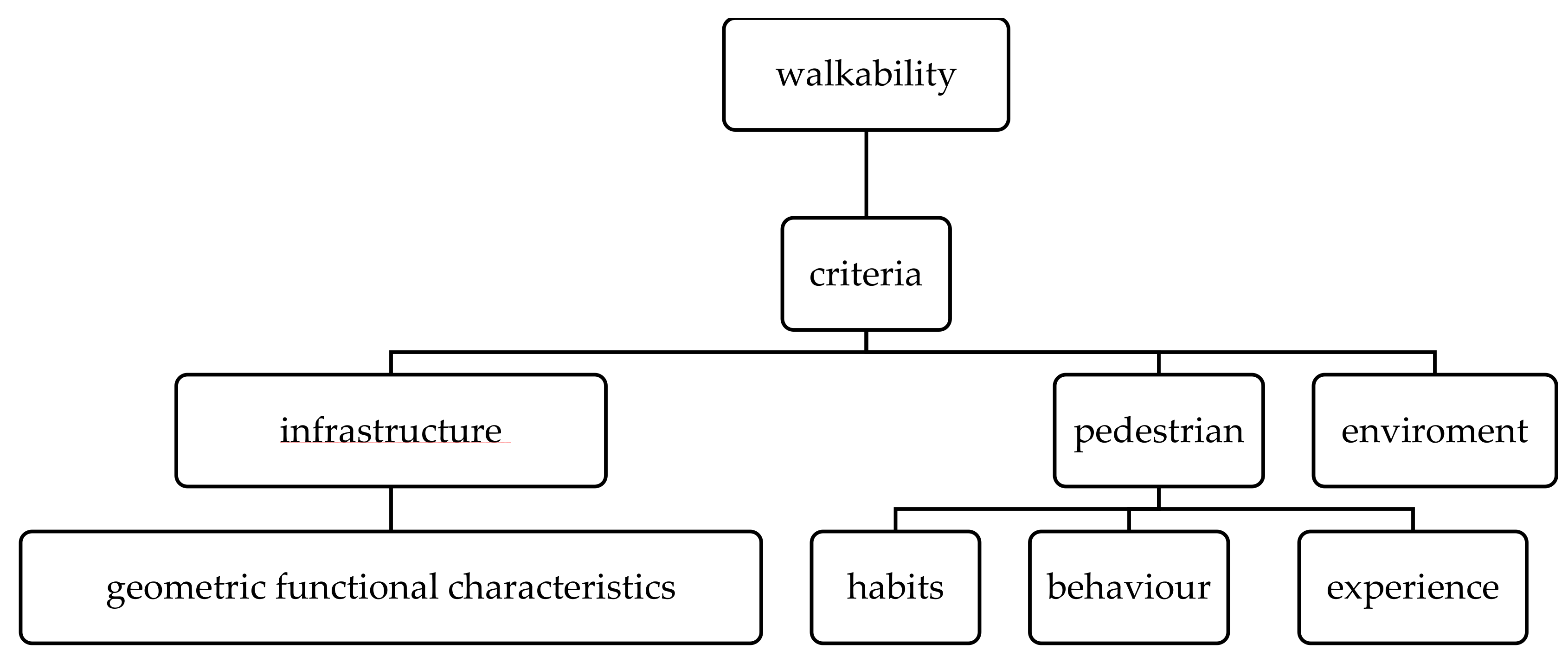
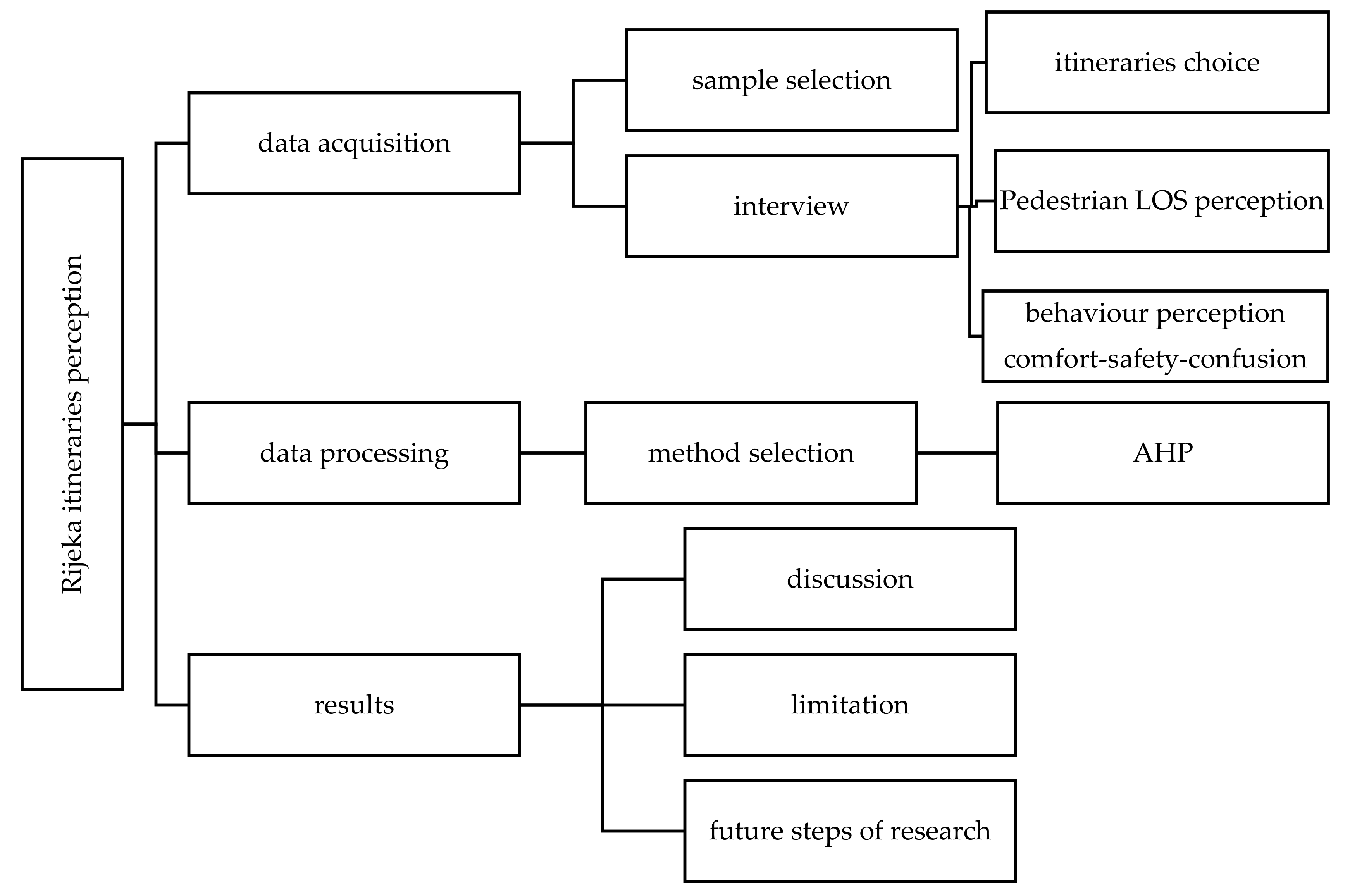
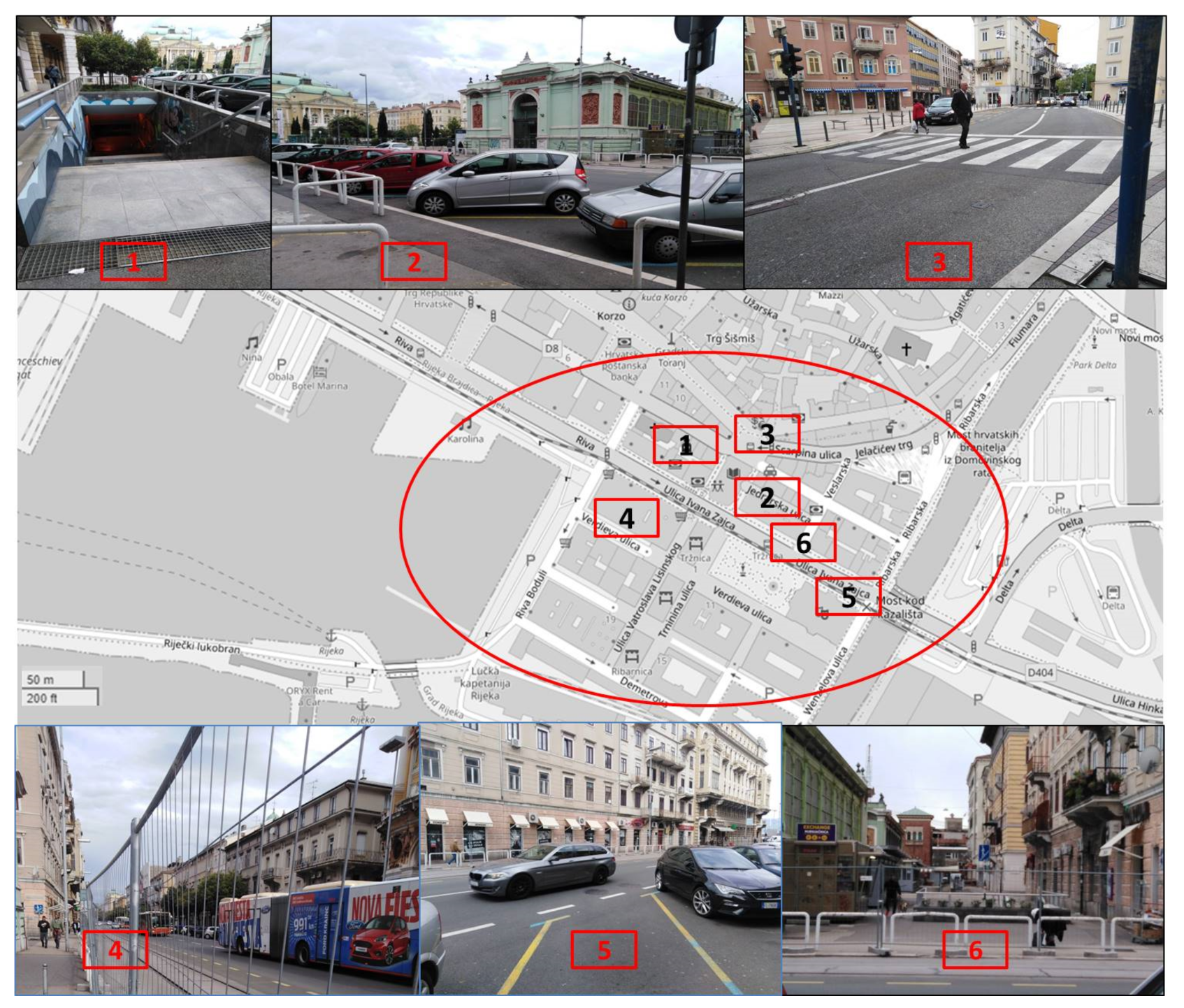
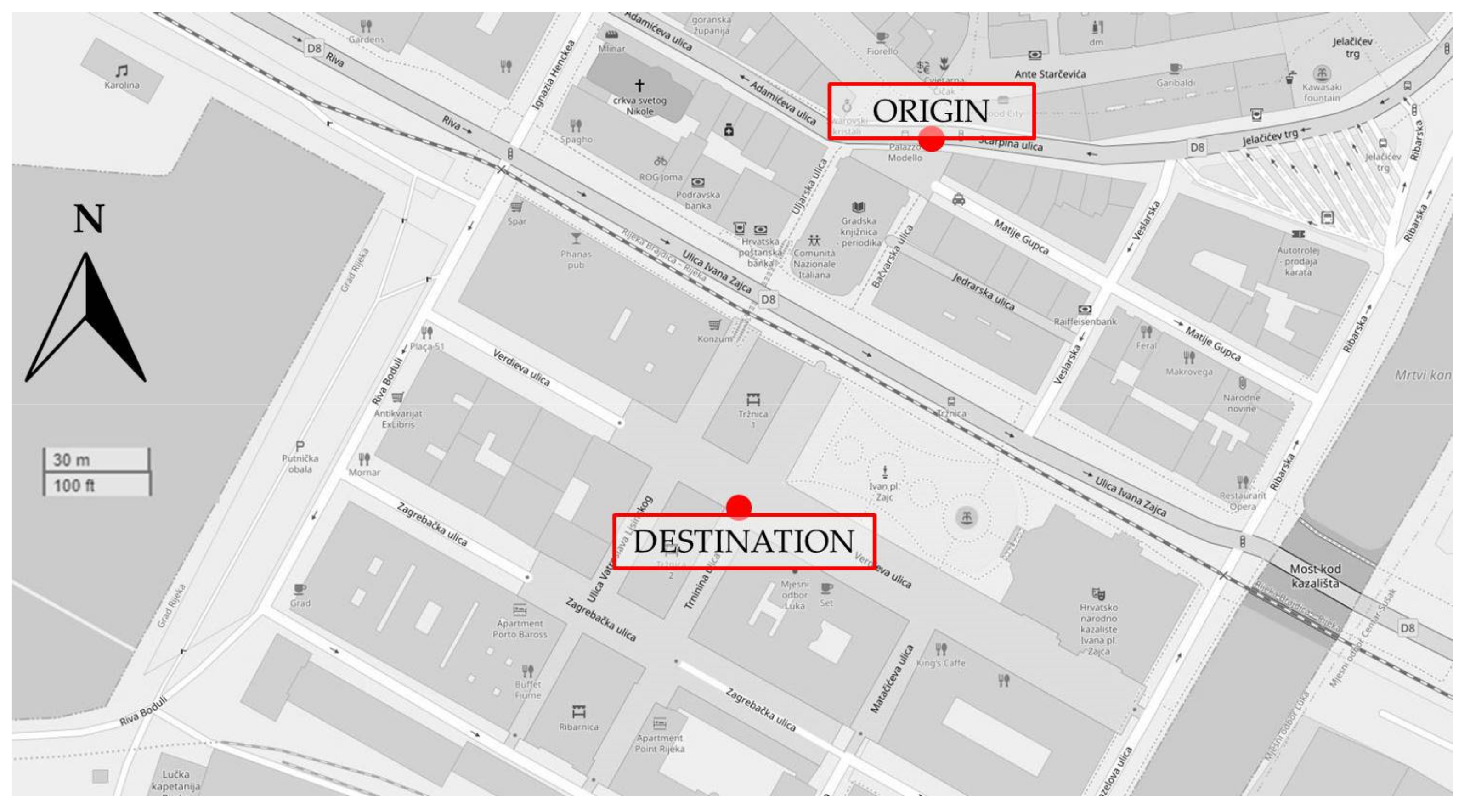
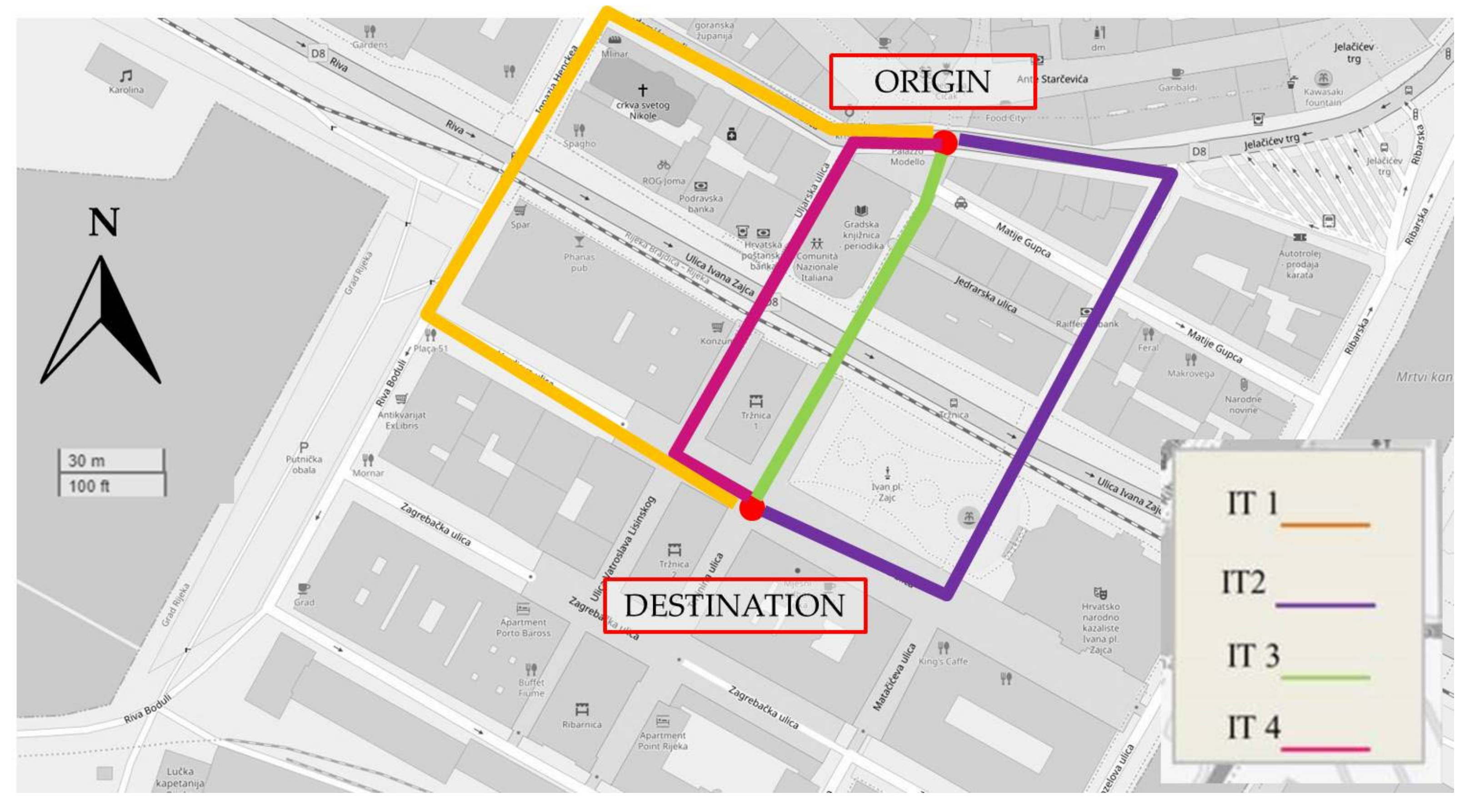
| Section 1 | Variable | Attribute | Variable | Attribute | Variable | Attribute | |||||
| Gender | Male Female | Age | 18–24 25–39 40–54 | 55–64 ≥ 65 | Job | Student Worker | Retiree Other | ||||
| Section 2 | Variable | Possible reply | Question | Possible reply | Question | Possible reply | Question | Possible reply (Likert scale) | |||
| road use frequency | Every day 4 times per week 2–3 times per week Once per week More rarely | itinerary selection | Itinerary 1 Itinerary 2 Itinerary 3 Itinerary 4 | Level of Service (LOS) of road network | A B C D E F | ease of access | 1 2 3 4 5 | ||||
| Section 3 | comparison of routes in pairs (AHP) | User perception | Scale | ||||||||
| comfort safe confusion | Saaty scale (0–4) | ||||||||||
| Gender | Frequency | Relative Frequency | Cumulative Relative Frequency |
|---|---|---|---|
| Male | 38 | 54.3% | 54.3% |
| Female | 32 | 45.7% | 100.0% |
| Total | 70 | 100.0% |
| Age | Frequency | Relative Frequency | Cumulative Relative Frequency |
|---|---|---|---|
| 18–24 | 43 | 61.4% | 61.4% |
| 25–39 | 20 | 28.6% | 90.0% |
| 40–54 | 5 | 7.1% | 97.1% |
| 55–64 | 1 | 1.4% | 98.6% |
| > 65 | 1 | 1.4% | 100.0% |
| Total | 70 | 100.0% |
| Profession | Frequency | Relative Frequency | Cumulative Relative Frequency |
|---|---|---|---|
| Student | 34 | 48.6% | 48.6% |
| Worker | 34 | 48.6% | 97.1% |
| Retiree | 1 | 1.4% | 98.6% |
| Other | 1 | 1.4% | 100.0% |
| Total | 70 | 100.0% |
| Use Frequency | Frequency | Relative Frequency | Cumulative Relative Frequency |
|---|---|---|---|
| Every day | 9 | 12.9% | 12.9% |
| 4 times per week | 18 | 25.7% | 38.6% |
| 2–3 times per week | 15 | 21.4% | 60.0% |
| Once per week | 10 | 14.3% | 74.3% |
| More rarely | 18 | 25.7% | 100.0% |
| Total | 70 | 100.0% |
| Route Travelled Most Frequently | Frequency | Relative Frequency | Cumulative Relative Frequency |
|---|---|---|---|
| Itinerary 1 | 19 | 27.1% | 27.1% |
| Itinerary 2 | 15 | 21.4% | 48.6% |
| Itinerary 3 | 14 | 20.0% | 68.6% |
| Itinerary 4 | 22 | 31.4% | 100.0% |
| Total | 70 | 100.0% |
| LOS | Frequency | Relative Frequency | Cumulative Relative Frequency |
|---|---|---|---|
| A | 1 | 1.4% | 1.4% |
| B | 5 | 7.1% | 8.6% |
| C | 44 | 62.9% | 71.4% |
| D | 15 | 21.4% | 92.9% |
| E | 5 | 7.1% | 100.0% |
| F | 0 | 0.0% | 100.0% |
| Total | 70 | 100.0 |
| Possibility to Go on Walk | Frequency | Relative Frequency | Cumulative Relative Frequency |
|---|---|---|---|
| Absolutely negative | 0 | 0.0% | 0.0 |
| Very negative | 1 | 1.4% | 1.4% |
| Negative | 3 | 4.3% | 5.7% |
| Positive | 32 | 45.7% | 51.4% |
| Very positive | 28 | 40.0% | 91.4% |
| Absolutely positive | 6 | 8.6% | 100.0% |
| Total | 70 | 100.0% |
| AHP RESULTS | ||||||||
|---|---|---|---|---|---|---|---|---|
| Comfort | Safety | Confusion | ||||||
| Routes | Weights | Ranking | Routes | Weights | Ranking | Routes | Weights | Ranking |
| Itinerary 1 | 22.0% | 3 | Itinerary 1 | 22.8% | 3 | Itinerary 1 | 29.6% | 1 |
| Itinerary 2 | 25.8% | 2 | Itinerary 2 | 23.6% | 2 | Itinerary 2 | 23.1% | 3 |
| Itinerary 3 | 21.8% | 4 | Itinerary 3 | 17.6% | 4 | Itinerary 3 | 28.8% | 2 |
| Itinerary 4 | 30.4% | 1 | Itinerary 4 | 36.0% | 1 | Itinerary 4 | 18.5% | 4 |
| Consistency Ratio (CR) = 1.1% | CR = 0.7% | CR = 0.2% | ||||||
Publisher’s Note: MDPI stays neutral with regard to jurisdictional claims in published maps and institutional affiliations. |
© 2020 by the authors. Licensee MDPI, Basel, Switzerland. This article is an open access article distributed under the terms and conditions of the Creative Commons Attribution (CC BY) license (http://creativecommons.org/licenses/by/4.0/).
Share and Cite
Campisi, T.; Basbas, S.; Tesoriere, G.; Trouva, M.; Papas, T.; Mrak, I. How to Create Walking Friendly Cities. A Multi-Criteria Analysis of the Central Open Market Area of Rijeka. Sustainability 2020, 12, 9470. https://doi.org/10.3390/su12229470
Campisi T, Basbas S, Tesoriere G, Trouva M, Papas T, Mrak I. How to Create Walking Friendly Cities. A Multi-Criteria Analysis of the Central Open Market Area of Rijeka. Sustainability. 2020; 12(22):9470. https://doi.org/10.3390/su12229470
Chicago/Turabian StyleCampisi, Tiziana, Socrates Basbas, Giovanni Tesoriere, Mirto Trouva, Thomas Papas, and Iva Mrak. 2020. "How to Create Walking Friendly Cities. A Multi-Criteria Analysis of the Central Open Market Area of Rijeka" Sustainability 12, no. 22: 9470. https://doi.org/10.3390/su12229470
APA StyleCampisi, T., Basbas, S., Tesoriere, G., Trouva, M., Papas, T., & Mrak, I. (2020). How to Create Walking Friendly Cities. A Multi-Criteria Analysis of the Central Open Market Area of Rijeka. Sustainability, 12(22), 9470. https://doi.org/10.3390/su12229470











